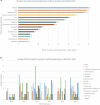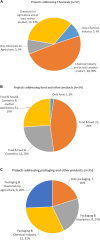Developing a Sustainable and Circular Bio-Based Economy in EU: By Partnering Across Sectors, Upscaling and Using New Knowledge Faster, and For the Benefit of Climate, Environment & Biodiversity, and People & Business
- PMID: 33553123
- PMCID: PMC7860146
- DOI: 10.3389/fbioe.2020.619066
Developing a Sustainable and Circular Bio-Based Economy in EU: By Partnering Across Sectors, Upscaling and Using New Knowledge Faster, and For the Benefit of Climate, Environment & Biodiversity, and People & Business
Abstract
This paper gives an overview of development of the EU-bioeconomy, 2014-2020. The Vision of the new Circular Bio-based Economy, CBE is presented: Unlocking the full potential of all types of sustainably sourced biomass, crop residues, industrial side-streams, and wastes by transforming it into value-added products. The resulting product portfolio consists of a wide spectrum of value-added products, addressing societal and consumer needs. Food and feed, bio-based chemicals, materials, health-promoting products; and bio-based fuels. The pillars of CBE are described, including biotechnology, microbial production, enzyme technology, green chemistry, integrated physical/chemical processing, policies, conducive framework conditions and public private partnerships. Drivers of CBE are analyzed: Biomass supply, biorefineries, value chain clusters, rural development, farmers, foresters and mariners; urgent need for climate change mitigation and adaptation, and stopping biodiversity loss. Improved framework conditions can be drivers but also obstacles if not updated to the era of circularity. Key figures, across the entire BBI-JU project portfolio (2014-2020) are provided, including expansion into biomass feedstocks, terrestrial and aquatic, and an impressive broadening of bio-based product portfolio, including higher-value, health-promoting products for man, animal, plants and soil. Parallel to this, diversification of industrial segments and types of funding instruments developed, reflecting industrial needs and academic research involvement. Impact assessment is highlighted. A number of specific recommendations are given; e.g., including international win/win CBE-collaborations, as e.g., expanding African EU collaboration into CBE. In contrast to fossil resources biological resources are found worldwide. In its outset, circular bio-based economy, can be implemented all over, in a just manner, not the least stimulating rural development.
Keywords: Bio-Based Industries Joint Undertaking (BBI-JU); Biobased Industries Consortium (BIC); Circular Bio-based Economy (CBE); bio-based products; biorefinery technologies; microbial production; side-streams & wastes; upgrading.
Copyright © 2021 Lange, Connor, Arason, Bundgård-Jørgensen, Canalis, Carrez, Gallagher, Gøtke, Huyghe, Jarry, Llorente, Marinova, Martins, Mengal, Paiano, Panoutsou, Rodrigues, Stengel, van der Meer and Vieira.
Conflict of interest statement
UB-J is the CEO and founder of the companyGate2Growth. Lene Lange is the founder and owner of the company BioEconomy, Research & Advisory. The remaining authors declare that the research was conducted in the absence of any commercial or financial relationships that could be construed as a potential conflict of interest.
Figures







References
-
- Abraham M. (ed.) (2017). Encyclopedia of Sustainable Technologies, Science Direct. Amsterdam:Elsevier.
-
- BBI-JU. (2014). 2014 Call. Available online at: https://www.bbi-europe.eu/participate/calls-proposals-2014 (accessed December 17, 2020).
-
- BBI-JU. (2018). Nova Institute Reporting. Current Situation and Trends of the bio-BASED Industries in Europe. Available online at: https://www.bbi-europe.eu/news/bbi-ju-presents-study-current-situation-a... (accessed December 17, 2020).
-
- BBI-JU. (2019). About BBI-JU. Available online at: https://www.bbi-europe.eu/about/about-bbi (accessed December 17, 2020).
-
- BBI-JU. (2020a). Annual Work Plan. Available online at https://www.bbi-europe.eu/publications (accessed December 17, 2020).
Publication types
LinkOut - more resources
Full Text Sources
Other Literature Sources
Miscellaneous

